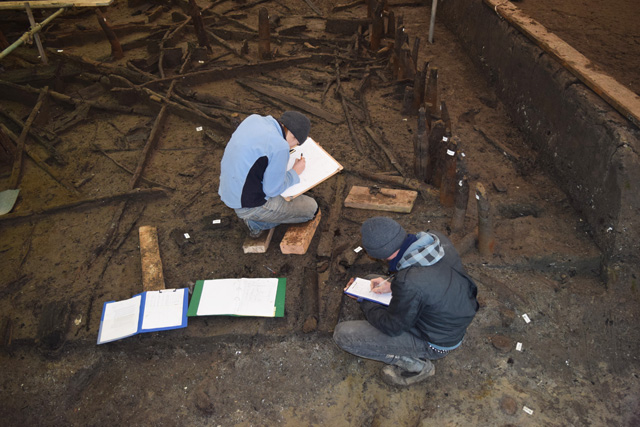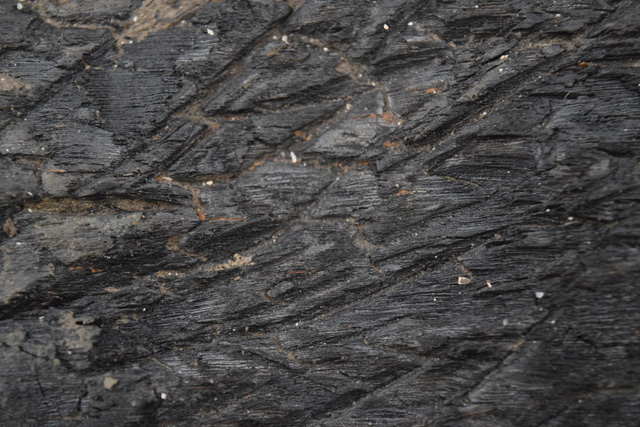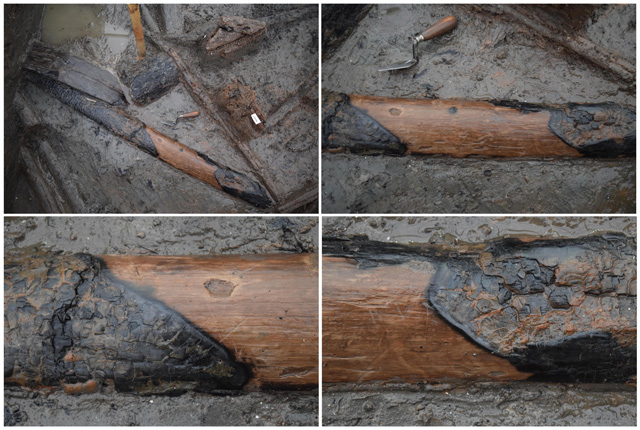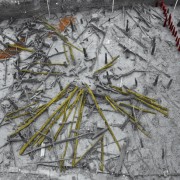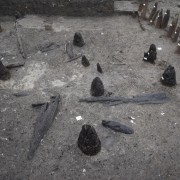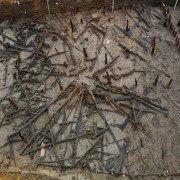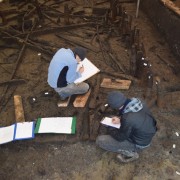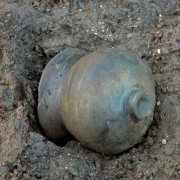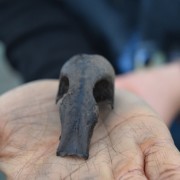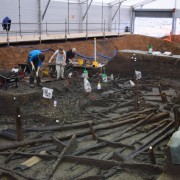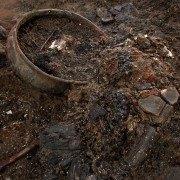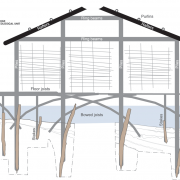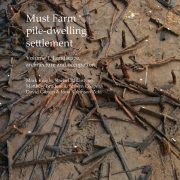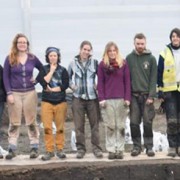Dig Diary 11: The Importance of the Wood Record
January 4, 2016
Recording the Wood
One thing that is so defining about the Must Farm excavation is the sheer quantity of wood. There are large oak uprights, ash posts, wooden poles, structural joints, wattle sheets, beaver-gnawed stakes and a very large amount of twigs and sticks. In just over two months we have already numbered over 550 individual bits of wood which represents a small portion of the site overall. As we continue to uncover the burnt wood mass this number is likely to double or triple as a conservative estimate.
With such a large quantity of a very important material it is essential to make the most of the information that we can learn from it. We are ensuring that we are using a very robust, thorough system to record this information which will also help us to spot any potential patterns as we work. Our initial step is to clean and examine the wood, which we have described in more detail in this dairy entry.
Once this preliminary work is completed each area of the wood mass is recorded with photogrammetry, using a standard digital SLR camera with an 18-55mm lens. The photos taken are then processed using a software package, Agisoft Photoscan, which can be used to create everything from movable 3D models to traditional scale plans of the wood mass. After this is done our photographer takes a series of record shots for the archive from multiple angles which is the last stage before more detailed recording begins.
Owing to the wide variety of timbers present in the wood mass we have a dedicated wood specialist, Michael Bamforth from the University of York, who works with the team to assist with the process. Firstly we examine the wood to see if it needs any further cleaning before recording its dimensions. The wood is then carefully examined to see if it can be visually identified: something which is only possible for ash and oak. We are very fortunate as much of the timber we are encountering on site is one of these two species. If the wood is not oak or ash, a small portion is sampled and sent away to specialists to be identified using microscopy.
Another key element is trying to establish if the piece of wood has been coppiced. Coppicing is a type of woodland management that has been practiced throughout prehistory. The technique involves cutting a tree down but leaving a portion of the stump or roots in the ground. In many species this encourages new growth to occur and the tree will regrow ready to be cut down again after a number of years. Identifying coppiced wood can give us information about the type of landscape activity that was occurring elsewhere in the landscape during the later Bronze Age. It can also be used to compare tree ring growth cycles in the timbers, which can provide valuable information that can identify if wood was being used from the same area of coppiced woodland.
Alongside wood species and its source, whether a piece of timber has been subject to any working is very important. The types of working vary significantly and could be anything from the wood being split, straightened or displaying evidence of tool marks. This can be extremely useful and, in some instances, the markings can leave the exact indentation of the tool or tools used to work the wood. We are also interested in any other markings, even if they occurred post-deposition. Already we have seen beaver-gnawed ends of timbers that have otherwise been burnt and even beetle markings. While these may not seem particularly important they can give us information about the wider environment and ecology of the site.
One of the final aspects of the wood we are keen to examine is whether or not there is evidence of charring on a piece. Given the nature of the fire both the extent and depth of the charring is important and can help us to understand the blaze in more detail. Of particular interest are any timbers that have both burnt and unburnt sections, which are extremely useful in recreating their potential positions within the structure.
Even some of the smallest pieces of wood are proving to be extremely important. Wood chips, thought to be from the construction of the palisade, are usually no more than 10-15cms in size but are helping explain the story of the site. The presence of these construction remnants in a deposit directly below the fire debris suggests the palisade was created shortly before the settlement burnt down. However, we are now discovering some of these wood chips with burning on only one side when previously we only had unburnt pieces. The implications for this discovery aren’t quite clear but understanding these burnt wood chips is going to be an important element in unpicking the sequence of events at the site.
Efficient and detailed recording of the wood mass and the uprights is an absolutely critical element to this project. It is an extremely time-consuming task requiring expert knowledge and an excellent grasp of the material. However, the amount of information we will gain from this is invaluable to us and will form part of the basis for understanding this site. With a large portion of the wood mass still to be examined we are expecting to discover some surprises and, hopefully, more of the story about the destruction of this amazing settlement.
Related stories
Dig Diary 14: Excavating our Structures
January 25, 2016
Dig Diary 13: Exploring Our Earlier Oak Post Alignment
January 18, 2016
Dig Diary 12: Discovering Our First House
January 11, 2016
Dig Diary 11: The Importance of the Wood Record
January 4, 2016
Dig Diary 10: Looking Further Afield
December 21, 2015
Dig Diary 9: The Site and its Environment
December 14, 2015
Dig Diary 8: Understanding the Site
December 7, 2015
Dig Diary 7: What is the Timber Platform?
November 30, 2015
Learn more
About
The Must Farm pile-dwelling settlement was excavated by the Cambridge Archaeological Unit with funding from Historic England and Forterra.Publications
Read the Open Access publications the Must Farm pile-dwelling settlement: Volume 1. Landscape, architecture and occupation and Volume 2. Specialist reports.Post-Ex Diaries
Our work on-site has finished but lots more investigation is taking place as we study both the material and the evidence we recovered. ...read more
Discoveries
See some of the discoveries from the Must Farm pile-dwelling settlement.
Making Must Farm
Find out about our work with AncientCraft recreating Must Farm’s material.
FAQs
Further information on the Must Farm project.

